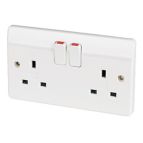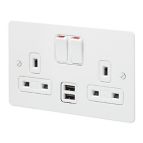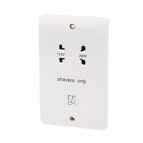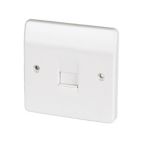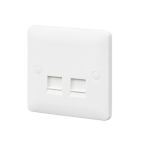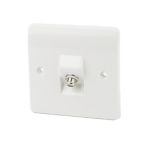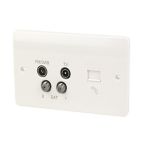Electrical socket buying guide
Electrical socket buying guide
Introduction
If you’re buying a replacement plug socket or updating all the sockets in a property, it’s important to know your options to get the right ones for your needs.
This buying guide tells you all you need to know about plug sockets. It covers how they work, what ‘gangs’ mean, and the types and styles of electrical sockets available. We also give you tips on fitting sockets and highlight things to consider before buying.
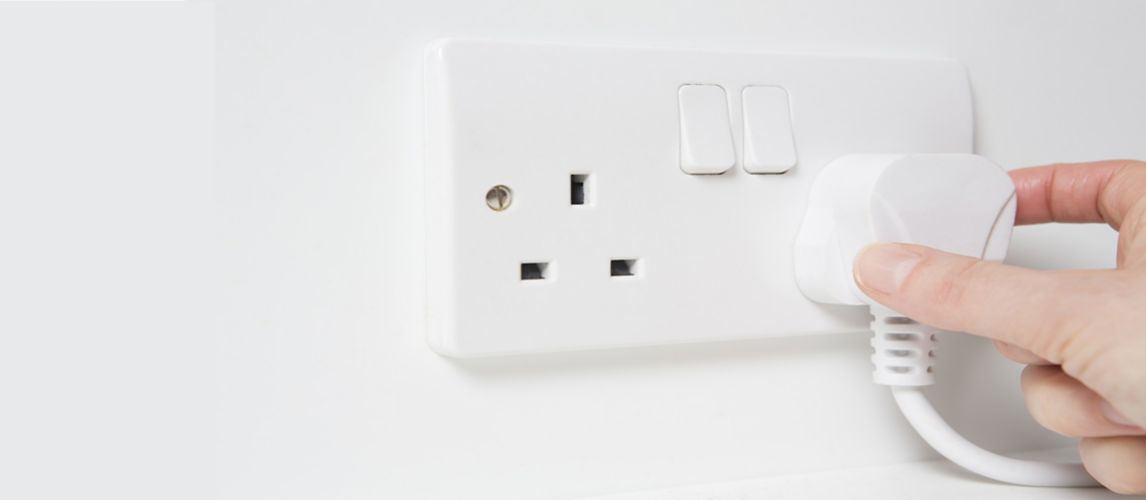
How Does a Plug Socket Work?
Plug sockets are made up of three main parts:
- A backbox (also called a pattress or mounting box) can be recessed into a wall or mounted to a surface.
- The electrical wiring is housed inside the backbox.
- A faceplate, which is screwed to the backbox, acts as a lid. This is the visible part of the socket.
The wires within the socket are connected to the home’s consumer unit through electrical cables hidden in the walls. The faceplate is then wired to the backbox to form an electrical circuit.
There are many types of electrical sockets available for different uses. So, in addition to standard plug sockets, there are also sockets available for TVs, phones and ethernet cables, for example.
Electrical sockets are often replaced simply to update them to suit room décor. But, to prevent the risk of electric shocks or a fire, they should be replaced if they’re showing any of the following signs of wear and tear:
-
Heat scorch marks around the plug pinholes
-
Fuses blow when the socket is used
-
Plugs slide in and out of the socket too easily
-
A burning smell or visible smoke
-
Crackling or popping sounds when the socket is in use
-
The socket or plug feels hot
Understanding Gangs in Sockets
Gangs is the term used to tell you how many sockets there are on a single faceplate. Each gang provides space for one item to be plugged in. Depending on the type of socket, that item could be a plug, an ethernet cable, a TV aerial, etc.
So, as an example, a 1-gang plug socket has space for one plug, and a 2-gang plug socket has space for two plugs.
Some plug sockets also have space to plug in USB chargers. The ports for USB chargers are called outlets.
Types of Electrical Socket
There are several types of electrical sockets available which all have different uses. This section runs through all the different types you'll find around the home to help you find the right one for your needs.
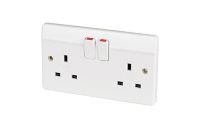
Plug Sockets Explained
As you know, plug sockets are the type of socket used to plug-in electrical appliances or devices such as lamps, hairdryers, printers etc. There are a few different types available as follows:
Double plug sockets have 2-gangs, meaning they have space to plug in two items. On most double sockets, each gang has a switch that allows the electricity supply to be turned on and off, although there are some without switches. Some double plug sockets also have outlets for USB chargers.
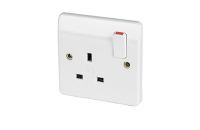
Single plug sockets have 1-gang, meaning they have space to plug in one item. Although some don't, most single plug sockets have a switch to turn the electricity supply on and off. And, some single plug sockets also have outlets for USB chargers.
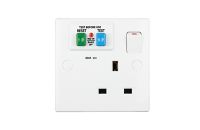
RCD sockets are double or single plug sockets with a built-in RCD (residual current device) designed to cut the power if a fault with the current is detected. This helps protect users from electric shocks and prevents damage to the plugged-in item.
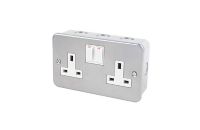
Metal clad sockets are double or single, heavy-duty plug sockets designed to withstand high usage and accidental damage. For this reason, they’re ideal for use in industrial and commercial settings but are also used in home garages. Some metal clad sockets also have built-in RCD’s or outlets for USB chargers.
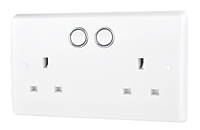
Smart Plug Socket Types
Smart plug sockets are like standard plug sockets, but with the added benefit of internet connectivity. Using WiFi, they connect to an app on a smartphone or tablet and allow users to control the power to the socket at any time, from anywhere, automate them with schedules or set timers. They can also be connected to other smart devices as part of a more extensive smart home system. Read our smart plugs and switches buying guide to find out more.
Smart plug sockets offer many benefits. They can be installed in hard-to-reach places, such as behind furniture, so the socket can be controlled through the app or voice commands. Or users can check dangerous appliances, such as hair straighteners, have been turned off after they’ve left the house. Most are available with switches so they can be controlled manually as well as remotely.
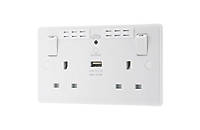
WiFi Extender Socket Types
WiFi extender sockets are plug sockets with built-in technology that boosts WiFi strength in a home. They work using a WPS connection to connect to the home's internet router. They are a convenient way of boosting WiFi in weak areas without adding additional wires or adapters. The wireless range and data transfer rate of WiFi extenders make them ideal for web browsing and even for gaming. Some WiFi extender sockets also have outlets for USB chargers. They are available in various styles and finishes, so a suitable socket can be found to suit any home's décor
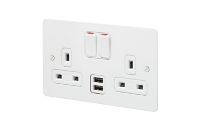
USB Socket Types
USB sockets are single or double plug sockets with extra outlets for plugging in USB chargers. This makes them ideal for charging portable devices such as smartphones and tablets without using the plugs that come with them. This frees up the plug sockets for other items.
USB plug sockets are typically available with between one and three USB outlets. They all have outlets for type A USB chargers (most used). And some also have outlets for type C chargers (a newer type of fast charger commonly used on MacBook Pros and Nintendo Switches, for example).
It's essential to choose the correct amp rating of a USB wall socket to match the devices being charged. A mains socket will typically split the amp rating by the number of USB connections. So, if one device is plugged in, it will get all the power. If two are plugged in, each will get half the power. USB sockets are typically available with an output of 2 amps, 2.1 amps, 3.1 amps and 4.2 amps. If more than one device is likely to be plugged in, or those devices use a high amount of power, choose a higher amp.
USB sockets are available in various styles and finishes, so a suitable socket can be found to suit any home’s décor.
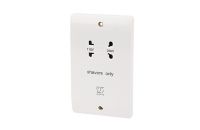
Shaver Socket Types
Shaver sockets are typically installed in bathrooms to safely provide power and recharge electric shavers and toothbrushes that come with 2-pin plugs. They're designed to keep the user away from the electrical circuit to minimise the risk of electric shocks.
Shaver sockets are available in a wide choice of styles and finishes to suit any bathroom décor.
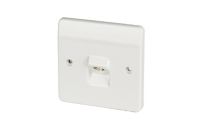
TV Socket Types
TV Sockets (also called aerial sockets or coaxial sockets) provide a connection between a television or signal receiver and the cable that runs to the aerial on a roof or in a loft. They can be installed in any room where a television is wanted. Each TV socket can take one aerial lead, plugged into one TV.
TV sockets are available in various styles and finishes to suit any décor.
Other Electrical Socket Types
The sockets described above are the most common. But there are others available:
-
Phone sockets connect home phones and other related devices (i.e., internet routers) to the local telephone network. A master phone socket is the main one that brings the external connection into the home. Then, slave phone sockets can be connected to the master phone socket to extend the phone line to other rooms.
-
Ethernet sockets connect internet routers or modems to the local broadband network. First, the socket brings the external connection into the home. Then, an RJ45 ethernet cable runs from the ethernet socket into the internet router. Ethernet sockets are available with either one or two cable ports.
-
Satellite sockets connect satellite TV boxes to the satellite signal. First, the socket brings the external connection into the home. Then, a satellite cable runs from the satellite socket to the satellite box, which is connected by another cable to a TV.
-
Multimedia sockets connect several types of multimedia to their respective outside data sources, all on one socket. For example, they can have outlets for TV aerials, FM/DAB radio aerials, satellite signals and ethernet cables. They’re available in a range of combinations.
Choosing Socket Colours and Finishes
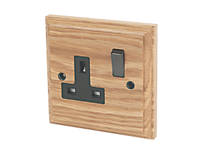
White sockets are the most common type of socket available. But there’s also a wide range of other, more decorative colours and finishes, so home and business owners can match their sockets to their décor.
For example, other socket colours available from Screwfix include black, blue, brown, grey and red. Then there are metal effect sockets, such as black nickel, brass, bronze, chrome, copper, iridium and steel. These metal effects can come in different finishes, such as gloss, matt, antique, brushed, polished or satin. And finally, there are more unusual sockets, such as glass sockets and wood effect sockets.
Sockets also come with different profiles, describing how the socket stands out from the wall. For example, raised profiles with rounded, square or bevelled edges stand a few millimetres out from the wall. There are slim raised profiles that stand out less. And there are flat profiles that are almost flush with the wall.
And finally, switches can be screwed or screwless. On screwed sockets, the screws are visible. But a screwless socket has a clip-on faceplate which means there are no visible screws.
If you are replacing electrical switches and sockets, it’s worth checking out the ranges for both if you want them to match.
Installing a Plug Socket
Installing an electrical socket can be a simple or complex task, depending on what type of socket you're replacing or adding.
For example, carrying out a like-for-like replacement of any electrical socket is a simple task for a competent DIYer. It involves removing the faceplate of the old socket and fitting the new socket. Socket wiring is simple, and you can take a photo of the wiring in the old socket to make connecting the wires in the new one easier. Before you start, check what depth back box you need for the new socket, as it may differ from the one already installed.
Swapping a single socket for a double socket, adding a plug socket to a room or installing any type of socket in a new location is more complicated and you should always consult a qualified electrician. For example, larger or new holes will need to be cut out of the wall to accommodate a bigger or new backbox. And cables may need to be channelled into the walls to connect new sockets to their source (i.e., the consumer unit, phone network, TV aerial etc.). Installing multimedia sockets is also a challenging task involving running multiple power source cables to one location.
Electrical sockets don't always have to be installed on walls. Some sockets can be installed on desks and some pop out of worktops. The fitting can be carried out by a competent DIYer, but holes will need to be cut out to accommodate the sockets. So, great care should be taken as there's only one chance to get that right.
Positioning a plug socket
If you're installing new electrical sockets, something to consider is their positioning. Particularly in a new build, where there are rules that take into account easy access for someone with limited means. For example:
-
Plug sockets must be at least 450mm up from the floor.
-
TV and phone sockets must be a maximum of 1200mm from the floor.
-
All types of sockets must be at least 350mm from the corners of rooms.
-
These rules don't apply in un-inhabited rooms such as garages and kitchens.
-
When installing new kitchen sockets, there should be a minimum of 100mm from the worktop to the bottom of the socket. This allows enough space to stop the cable from getting bent and damaged where it comes out of the plug.
Due to the dangers of mixing water and electricity, shaver sockets in bathrooms are subject to Part P Building Regulations. This means they must be installed by a qualified electrician who’s approved by a government-approved Part P scheme.
4 Things to Consider Before Buying Sockets
It’s always important to do your research before buying electrical sockets to ensure you’re getting the right product for your needs.
Here are four other things to consider:
1. How many wall sockets should be in a room?
The number of sockets needed in a room depends on what the space is used for, how big it is and what devices need to be plugged in. As a guide, a living room needs 4-8 sockets, a single bedroom needs 2-4, a double bedroom needs 3-5, and a kitchen needs 6-10. In most cases, it’s always better to have more sockets than you think you’ll need as it stops the use of extension leads.
2. What colour or finish are you looking for?
White plastic sockets are often the default colour people go for but consider if other colours and finishes would suit the décor better. For example, brushed or polished chrome or slate grey are perfect finishes to match contemporary décor. Or if the décor is more traditional, there’s antique brass or wood effects. Also, think about how the colours will complement or match other items in the room, such as appliances, door handles or window openings. And don’t forget, you can choose different colours and finishes for different rooms if necessary.
3. How high should power sockets be?
If new power sockets are being installed into an existing home, it's best to place them at the same height as all the other sockets in the house. If they're being installed into a new build house, they must be at least 450mm up from the floor and 350mm away from the corners of rooms to pass building regulations. Power sockets in kitchens should be at least 100mm above the worktop in all homes.
4. Smart compatibility
If the home has other smart devices installed (i.e., smart lights, security, speakers, etc.), smart sockets can be connected to them to create automation. For example, to scare off burglars, a smart socket can turn on a radio if movement is detected by a smart motion detector when no one's home. If there are no other smart devices installed yet, consider what may be needed in future. Either way, always check that smart devices are compatible with each other.

